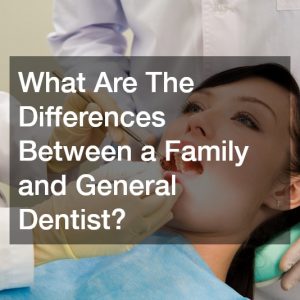Almost every member of the family needs to plan regular visits to a good dentist. Dentists are responsible for regular oral and gum exams and assisting clients with problems with their teeth and gums. Although general dentists can handle most routine dental problems, many issues are better addressed by visiting a dental specialist. Here are some of the dental specialists that you or a family member may need:
Family Dentists

Family dentists treat clients of all ages, from small children to elderly clients. Many families feel it’s a good idea to have the same dentist for all their family members. Family dentists enjoy the prospect of caring for several members of the family. Taking care of the whole family may allow the dentist to see a pattern of dental problems that need proactive care.
Local family dentists will perform routine dental examinations and handle patients who come for help with cavities or toothaches. During a visit with a family dentist, clients will most likely get dental X-rays, have a dental examination, and receive treatment for their dental problems. Family dentists can combine the educational information they give to one family member into one teaching session that will include everyone from the family.
Because family dentists treat patients of almost any age, they need training in how to approach clients from different age groups. For example, a geriatric client may have several types of dental problems due to years of poor dental hygiene. A pediatric client would need a patient and compassionate approach. Children also require different dosages of medication, and a family dentist must take that into consideration.
Cleaning Teeth
Many dentists will schedule periodic dental cleaning service activities for their clients. No matter how well a client brushes and flosses their teeth, it is inevitable that some tartar may build up on your teeth. A dental hygienist does dental cleaning services. The hygienist will use special cleaning instruments and apply fluoride to the teeth.
These cleanings are part of a client’s routine dental services and are typically covered by dental insurance. There is more than one type of dental cleaning service. Prophylactic (preventive) cleaning is done to prevent cavities, and it is when fluoride is applied to the teeth. Deep cleaning (sometimes called scaling or root planing) uses a special instrument to remove hardened tartar (called calculus) from the teeth.
Transparent Braces
If a dentist determines that a client’s teeth are misaligned or that they need their teeth straightened, they may send that client to an orthodontist. The orthodontist will then order braces to correct the angle of alignment. Traditional braces are made of metal with rubber bands, but many people today prefer to use invisible braces, better known as Invisalign.
Invisalign dentists will examine your mouth and decide whether Invisalign is right for you. The first visit will also include digital images (a computerized x-ray) and explain how the process will work. When you receive your first aligner, it will fit precisely over your teeth and stay in place with small clips. As each new set of aligners is used, they will exert pressure on your teeth to pull them into the correct alignment.
One of the unique advantages of Invisalign dental services is the ability to remove them to brush and floss your teeth. The duration of the treatment varies for each client. You’ll be glad to know that, except for some brief discomfort, Invisalign braces don’t hurt. As each tray gradually adjusts the alignment of your teeth, you will be moving closer to perfect alignment.
Replacing Teeth

If you have had to have a tooth pulled, your ability to chew will be compromised. When there is a missing tooth in your mouth, it will cause your teeth to grow progressively apart. Therefore, your dentist will recommend the use of dental implants. Dental implants are metal tooth roots that provide a base for replacement teeth.
There are three parts to each dental implant. The first part is the implant: a metal screw which the dentist inserts into your jawbone. Next, the dentist attaches an abutment – a metal part which permanently screws into the implant. On top of the abutment will be a crown, which is the part of the implant that people will see.
Crowns for implants are typically made from porcelain. Porcelain resembles tooth enamel, and you can care for your implants like you do your natural teeth. Although placing more than one dental implant at one visit might require the dental services of an oral surgeon, inserting only one implant can typically be done by general dentists. Your dentist can answer any questions about how dental implants might fit into your overall plan for oral health.
Whitening Your Smile
Clients with teeth that aren’t as white as they might like may ask their dentist for teeth whitening services. Although kits are sold for those who want to do teeth whitening at home, the results aren’t guaranteed, and they are often temporary. Clients who want this service done correctly should choose to have it done at a dental office. Dentists who perform those dental services may also refer to it as teeth bleaching.
This name comes naturally, as the solution used for whitening is peroxide. According to WebMD, at-home bleach kits for teeth include 3% to 20% peroxide, while the solution used at the office is 15% to 43% peroxide. There are also methods of whitening that don’t use bleach.
Talk to your dentist about the pros and cons of teeth whitening procedures. Some dentists believe that too many of these procedures can be harmful to your teeth. Others believe that whitening is only temporary and, therefore, isn’t worth the expense. Your dentist is the best one to evaluate your teeth and advise you whether to have a whitening treatment.
Repairing Your Smile

If your teeth are differently colored, or you believe you have an unattractive smile, you may decide to go to one of your area’s local cosmetic dentists. A cosmetic dentist can perform various procedures to improve the appearance of their clients’ teeth. Some cases – such as a repair after an auto accident involving the face and jaw – could involve extensive surgery.
A cosmetic dentist is a specialist who can perform dental implants or teeth whitening. In addition, a cosmetic dentist can apply veneers and dental bonds. Veneers are thin, tooth-colored porcelain or ceramic shells that cover your teeth. Before they are placed on the teeth, the dentist will remove part of your enamel so the veneers can adhere to your teeth. Dental bonds place resin on the teeth and then melt the resin into place with ultraviolet light.
Clients who need fillings in teeth that are too decayed to be filled can usually be filled by a cosmetic dentist using inlays and outlays. An inlay is a filling placed into the center of the tooth and then bonded into place. An outlay is applied to the outer edge before it is bonded by the dentist.
Creating Dentures
If you have multiple missing teeth, many dentists recommend getting dentures – sometimes called false teeth. In addition to providing a complete smile, dentures support the anatomical structure of your lips and cheeks. They can also allow you to chew foods you may find difficult to chew due to missing teeth. Dentists that provide dentures aren’t usually called denture dentists; they’re called prosthodontics.
When you go to the prosthodontist, they will begin their dental services by examining and measuring your mouth and teeth. They will decide on the correct device and tell you whether you need complete or partial dentures. The dentist will then schedule two sessions to make impressions of your teeth and mouth.
The dentist may need to extract teeth to create a perfect smile. After your dentures arrive, the dentist will schedule a visit to try them on and see if they fit correctly. The dentures will typically be ready two weeks after the try-on appointment. It will be necessary to return to the prosthodontist for future visits to ensure they continue to fit well and that they are not causing any problems with your gums or palate.
Making Bridges

Clients with missing or decayed teeth may choose to get a dental bridge. Dental bridges are another of the dental services that a cosmetic dentist can provide. These bridges do not require surgery. A bridge will place an artificial tooth or a group of artificial teeth (the “bridge”) between two natural teeth. Bridges typically have metal bases, while the parts that look like teeth are made from porcelain or ceramic.
When you are being fitted for a bridge, you will recline in a dental chair. The measurement process may be uncomfortable, so the dentist typically gives you a local anesthetic with a small needle. A rubber mold will be made of your mouth and teeth in the place where the bridge will be inserted. You will get a temporary bridge where your missing teeth are.
During the visit when you get your bridge, the dentist will fit your permanent bridge into your mouth and provide you with instructions about how to care for it. Prospective clients can rest assured that bridges are not invasive and that their placement is safe.
Broken Teeth
If someone has a broken tooth, it can be painful or cause difficulty when they try to chew. It can also cause injury to the inside of their mouth. Clients who need broken teeth repair can typically find help from a cosmetic dentist or a general dentist. Repairing broken teeth can be done in many ways, and the dentist can decide which method is best for the client.
One dental service that can help someone with a broken or cracked tooth is dental bonding. The dentist will first roughen the surface of your current tooth so that the composite will adhere to it. After that, composite putty is applied to the teeth, and ultraviolet light is used to harden the bond. Once the composite is dry, the dentist will shape and polish it.
The same result can be accomplished with veneers – thin porcelain covers that fit over your teeth. If the broken part of the tooth is the top of the tooth, a dental crown can be a good option. A root canal (a procedure removing the root of a damaged tooth to prevent pain or infection) may need to be done before a crown since the crown will be placed over a dental implant if a client calls their dentist’s office when their tooth breaks, the dentist will advise them to come in for an appointment as soon as possible.
Dental Sedation
Many dental procedures cause pain, so a dentist will use local anesthesia (typically, Novocain.) General dentists will administer local anesthetic via a needle into the gums near the tooth that will be worked on. Some dentists will further prevent pain during the procedure by applying a numbing paste to the gums before injecting the needle. There are some dental offices that emphasize the services of a sedation dentist in order to alleviate pain and fear during dental services.
One common type of dental sedation is nitrous oxide (sometimes called “laughing gas.”) This medication is given by inhalation so that you will remain calm during your procedure. After the procedure, the dentist will provide 100% oxygen to remove the nitrous oxide from your system. Oral medication is another alternative for dental treatments.
When a dentist uses oral sedation, the client becomes sleepy but can communicate with the dentist. Dental sedation can also be given via an intravenous solution, which will cause the client to go to sleep and later have no memory of the procedure. Although IV sedation is typically the most profound form of dental sedation, some methods are sometimes performed under general anesthesia.
Dental offices are not only a place to get help for dental problems but also a good source of information about oral health. Basic dental hygiene is an essential element of overall health, and dentists can help reinforce those principles. If you need help from a dental specialist, I hope the above information will help you choose the correct dental specialty.





